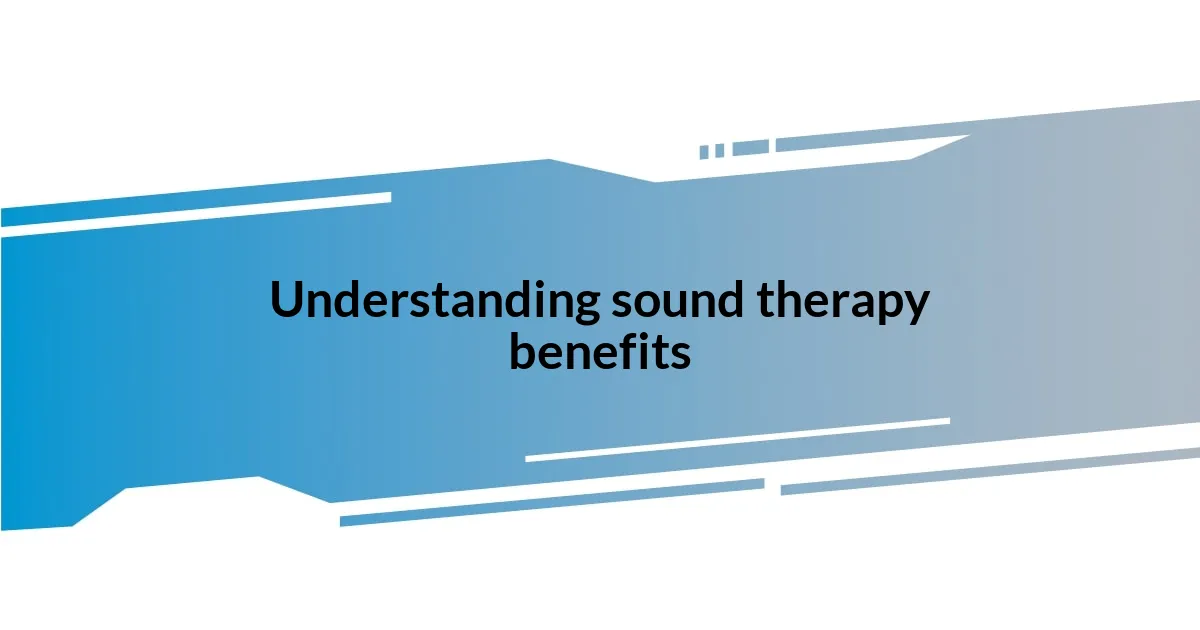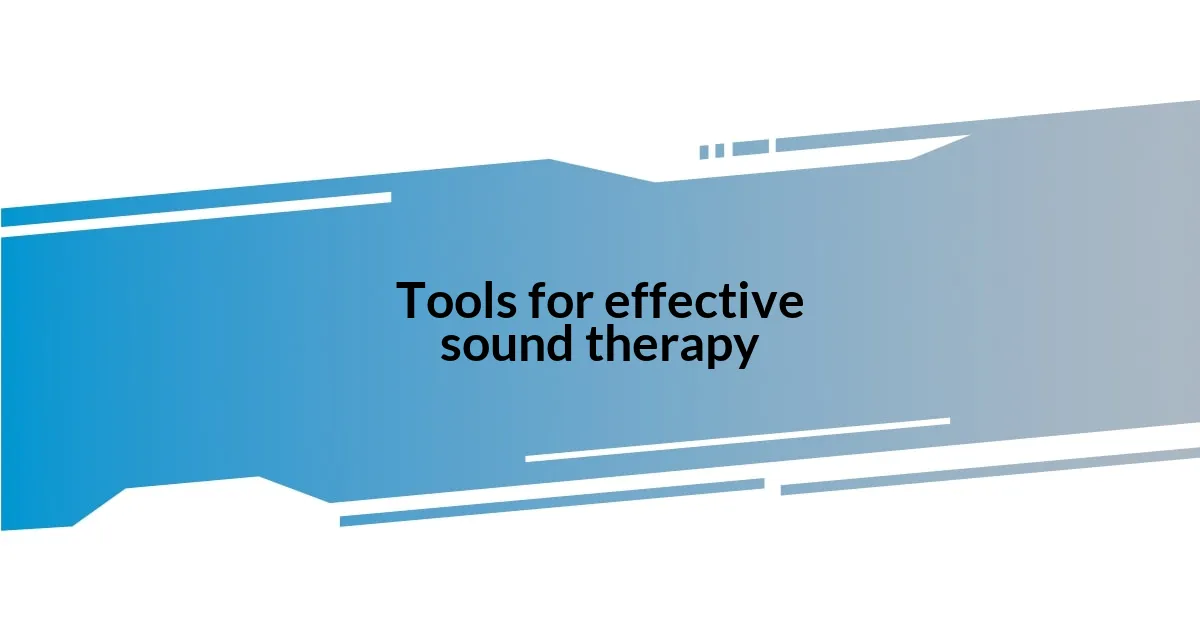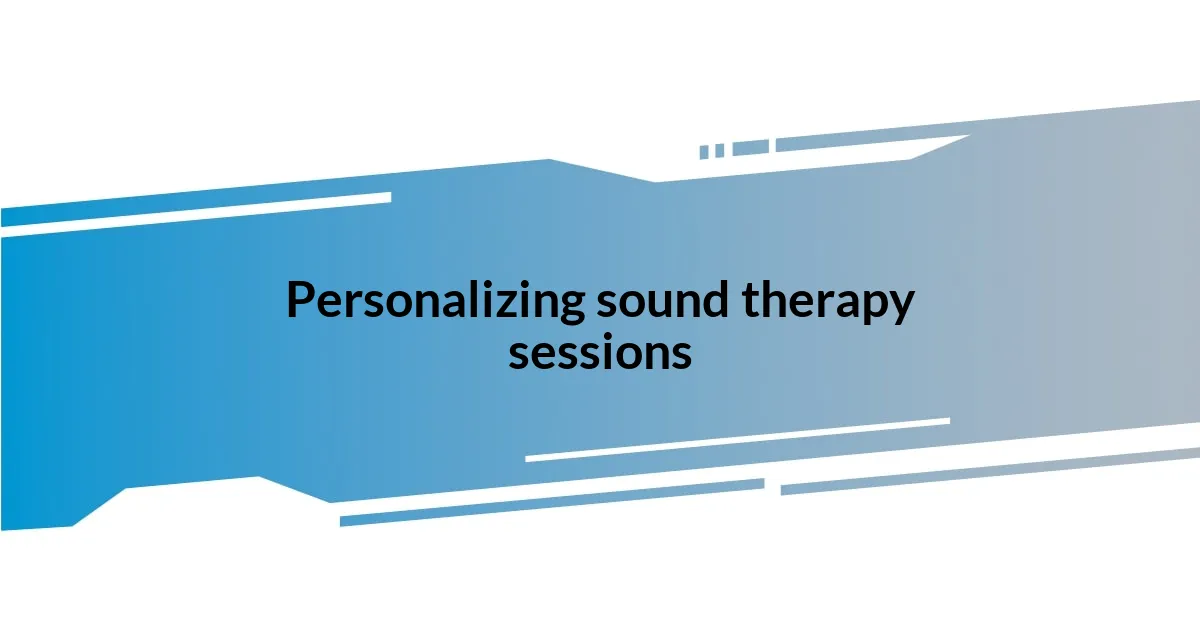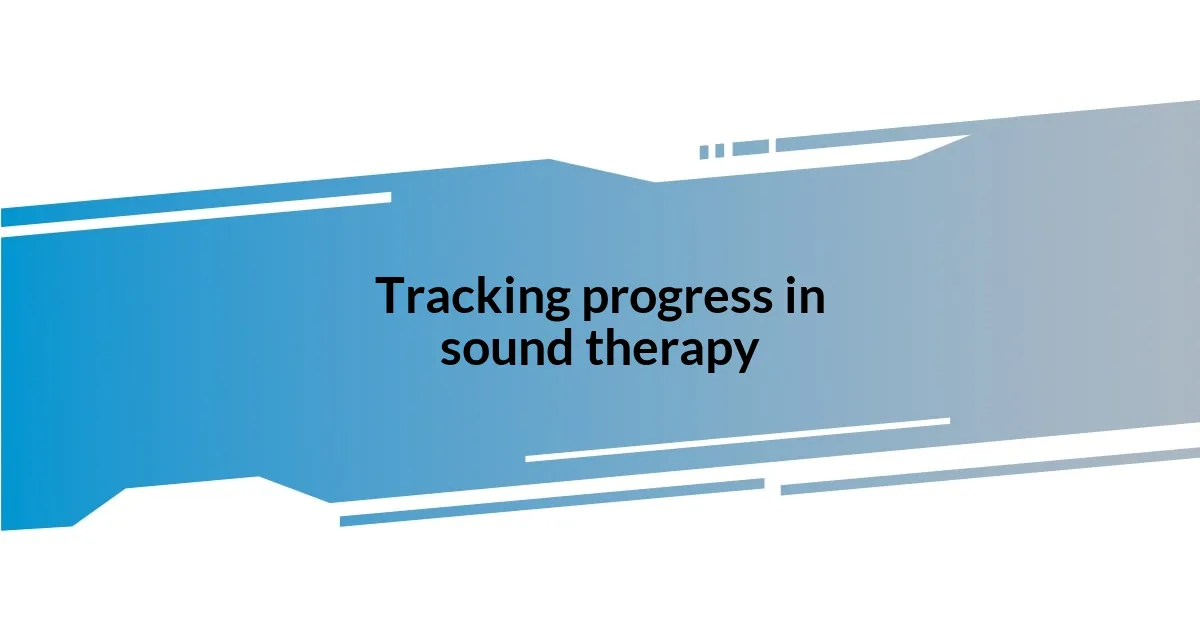Key takeaways:
- Sound therapy promotes relaxation, emotional balance, and mental clarity through various techniques like tuning forks, sound bathing, and guided sound meditation.
- Personalizing sound therapy sessions by adapting instruments and session lengths can enhance emotional release and self-discovery.
- Tracking progress, such as journaling after sessions, reveals patterns in emotional responses and deepens understanding of personal healing journeys.
- Evaluating the lingering effects of sound therapy helps in recognizing its impact on creativity, emotional connections, and overall well-being.

Understanding sound therapy benefits
Sound therapy offers a unique approach to wellness, tapping into the vibrational qualities of sound to promote relaxation and healing. I remember the first time I experienced a sound bath—immersed in the soothing tones of gongs and singing bowls. It felt as if the stress was literally washing away, leaving me more grounded and present. Isn’t it remarkable how a simple sound can shift your entire mood?
Moreover, sound therapy isn’t just about relaxation; it can also enhance mental clarity and emotional balance. I often recommend sound meditation to friends who struggle with anxiety. The gentle rhythms guide my thoughts, creating a space where worries lessen. It’s almost like having a reset button for the mind, don’t you think? This therapeutic quality is rooted in how sound frequencies interact with our brain waves, helping us to find harmony within ourselves.
On a deeper level, sound therapy connects us to our bodies and emotions. Have you ever noticed how certain songs evoke strong feelings or memories? I find that when I listen to specific frequencies, I can unlock emotions I didn’t even realize were buried deep inside. This powerful interplay can lead to profound self-discovery and healing, often in ways we could never anticipate. Such experiences make me appreciate the incredible power of sound in our lives.

Key techniques in sound therapy
One of the key techniques in sound therapy is the use of tuning forks. I remember the first time I tried them; the vibrations resonated in my body, creating this almost electric sense of alignment. It’s fascinating how precise frequencies can target specific energy centers, commonly referred to as chakras, ultimately promoting balance and healing. Each sound wave penetrates deeply, facilitating a release of tension that can be quite transformative.
Another technique I’ve found particularly potent is sound bathing. This practice involves lying down while various instruments like singing bowls and gongs create an immersive sound experience. I recall lying in a dimly lit room, the sounds swirling around me. It felt like I was floating in an ocean of sound, crafting a cocoon of serenity that whisked me away from my hectic thoughts. The collective vibrations seem to harmonize with my inner self, often leading to insights I hadn’t considered before.
Lastly, I must highlight the role of guided sound meditation. This approach often incorporates breathing exercises alongside sound, which has a unique way of deepening relaxation. During one memorable session, as the guide’s soothing voice led us through visualizations, I felt my body release layers of stress. Combining breath with sound creates a rich tapestry of experience that can foster profound emotional growth and understanding. It’s an approach I frequently return to when I feel overwhelmed by life’s demands.
| Technique | Description |
|---|---|
| Tuning Forks | Precise frequencies target chakras, creating alignment and balance. |
| Sound Bathing | Immersive experience with instruments that facilitate deep relaxation and insights. |
| Guided Sound Meditation | Merges sound with breathing exercises for emotional growth and stress relief. |

Tools for effective sound therapy
When it comes to sound therapy, having the right tools can significantly enhance the experience. I’ve found that high-quality sound bowls are a game changer. For instance, during one session, the resonance of a crystal singing bowl seemed to vibrate through my entire being, awakening parts of me that felt dormant. These bowls not only produce rich, melodious tones but also help in aligning energy within the body, creating a truly harmonious atmosphere.
I also highly recommend investing in a quality sound machine or an app. Many nights, I play soothing soundscapes—like gentle rain or ocean waves—while I drift off to sleep. I can’t express enough how those calming sounds have transformed my bedtime routine. Incorporating these tools can help establish a serene space for relaxation and healing.
- Sound Bowls: Rich tones that resonate and promote energetic alignment.
- Sound Machines/Apps: Help create soothing environments for better relaxation and sleep.
- Binaural Beats: Unique auditory illusion that can enhance focus and meditation by using two slightly different frequencies in each ear.
- Chimes: Their delicate and sustaining notes can clear negative energy and uplift the spirit.
- Tuning Forks: Used for precise chakra balancing, they offer a tactile and powerful experience, allowing you to feel the vibrations in your body.
Utilizing these tools has genuinely deepened my connection to the healing qualities of sound therapy, allowing me to explore my journey even further.

Personalizing sound therapy sessions
Personalizing sound therapy sessions is where the magic happens. I remember a particular instance when I tailored tuning fork frequencies to match my emotional state. Instead of a one-size-fits-all approach, I really tuned in—no pun intended— to what I was feeling that day. This allowed me to experience a level of healing that felt uniquely mine, highlighting the importance of adaptability in sound therapy.
There’s something incredibly liberating about selecting instruments based on personal preference. On a day when I felt weighed down by stress, I chose to incorporate lighter, high-pitched chimes. The brightness of their sound seemed to lift my spirits instantly! Have you ever experienced a particular sound that just resonates with your soul? For me, it transformed a routine session into a rejuvenating escape—a reminder that our individual needs guide the sound journey.
Moreover, experimenting with the length and duration of sound sessions made a noticeable difference. I once extended a sound bath to nearly two hours, being amazed by how deeper immersion unveiled layers of emotional release. It’s as if the sound wraps around you more completely with time. Have you tried adjusting the timing of your sessions? Personalizing these elements isn’t just about comfort; it often brings profound insights and healing—the type that invites you back for more.

Tracking progress in sound therapy
Tracking progress in sound therapy is essential to understand the impacts on our emotional and physical well-being. I remember the first time I started keeping a journal after each session. At first, it felt tedious, but soon it became clear how different sounds affected my mood, energy levels, and even sleep quality. Have you ever noticed how reflecting on your experiences can reveal patterns?
One night, after an intense sound bath, I wrote about feeling a profound sense of joy that hadn’t visited me in a while. By recording these moments, I could identify which instruments resonated with me most and how they corresponded to my inner state. It was like piecing together a jigsaw puzzle, where each sound contributed a significant part to the bigger picture of my emotional landscape.
I also found it helpful to track my responses over time. Initially, I would feel overwhelmed during certain sessions, unable to process the emotions that surfaced. However, as I continued, I noticed a shift. The same sounds that once felt intense began to oddly comfort me, almost like old friends returning. This evolution made me realize that sound therapy isn’t just about immediate relief; it’s about growth, allowing for a deeper understanding of oneself. Have you experienced similar shifts in your journey with sound? It can be incredibly enlightening.

Evaluating results in sound therapy
Evaluating results in sound therapy can be a rewarding journey of self-discovery. After each session, I like to reflect on how the sounds impacted me—not just immediately, but in the days that followed. Have you ever walked away from an experience and felt it linger in your mind? I once noticed that after a particularly resonant gong session, my creativity surged for the next few days. It taught me that the effects of sound therapy often resonate beyond the confines of the session itself.
What I find fascinating is how specific sounds can evoke distinct emotional responses. For instance, during one session, I was enveloped in deep, earthy tones that reminded me of being grounded in nature. It brought me a peace I hadn’t gone looking for but desperately needed. How often do we overlook the power of sound to connect us to our emotions? By recognizing these shifts, I’ve begun to appreciate each sound as a stepping stone in my emotional landscape.
As I continue this journey, I’ve learned to not only identify what works but also to embrace the nuances of my experiences. For instance, I used to shy away from certain frequencies that felt uncomfortable, but now, I view them as essential parts of my process. Have you ever reconsidered your reactions to certain sounds? Embracing the full range of experiences can lead to profound realizations about ourselves, highlighting that each session is part of a larger narrative of healing and growth.